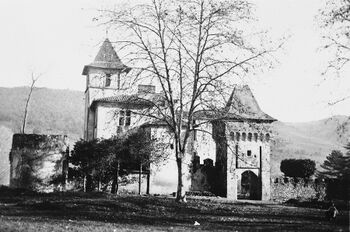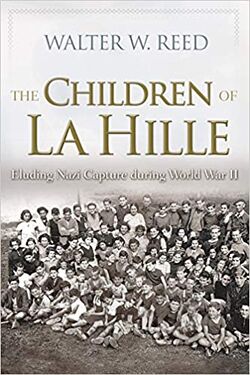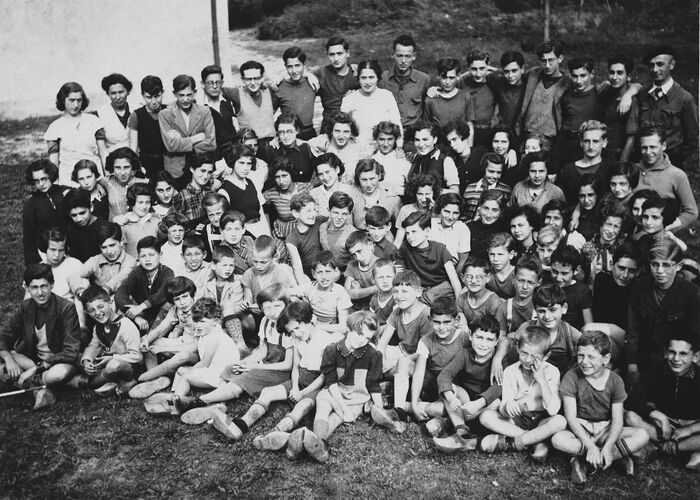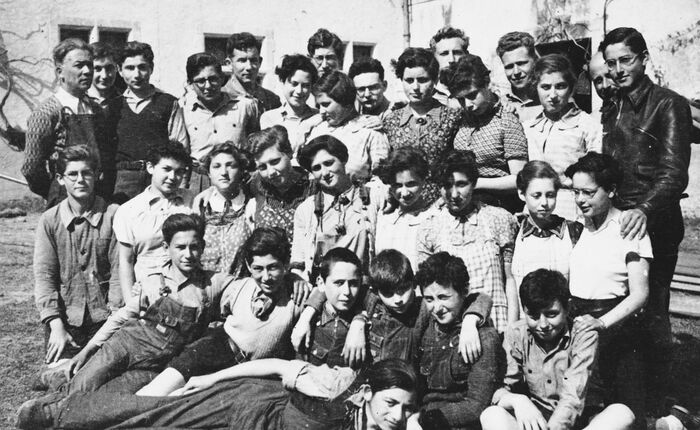Difference between revisions of "Category:Chateau de La Hille (subject)"
| Line 97: | Line 97: | ||
* 1940 / 1943 [[Inge Berlin]] - née en 1924 // son frère [[Egon Berlin]] - 1928 arrivent d'Allemagne par la Belgique à Seyre, puis sont envoyés au Château de la Hille. En 1942, les enfants de plus de 16 ans sont arrêtés et internés au Camp du Vernet. Rösli Näf* contacte immédiatement Maurice Dubois* qui demande à René Bousquet de relacher les enfants. Ils reviennent à la Hille en septembre 1942. Inge fait partie d'un groupe de cinq jeunes qui rejoindront l'Espagne, tandis que Egon reste en France et rejoint la résistance. Egon Berlin, meurt en combattant près de Roquefixade à l'âge de 16 ans. Il est enterré dans la cimetière de Pamiers. | * 1940 / 1943 [[Inge Berlin]] - née en 1924 // son frère [[Egon Berlin]] - 1928 arrivent d'Allemagne par la Belgique à Seyre, puis sont envoyés au Château de la Hille. En 1942, les enfants de plus de 16 ans sont arrêtés et internés au Camp du Vernet. Rösli Näf* contacte immédiatement Maurice Dubois* qui demande à René Bousquet de relacher les enfants. Ils reviennent à la Hille en septembre 1942. Inge fait partie d'un groupe de cinq jeunes qui rejoindront l'Espagne, tandis que Egon reste en France et rejoint la résistance. Egon Berlin, meurt en combattant près de Roquefixade à l'âge de 16 ans. Il est enterré dans la cimetière de Pamiers. | ||
* [[Rosalie Blau]] | |||
* 1941 / 1942 [[Edgar Chaim]] | * 1941 / 1942 [[Edgar Chaim]] | ||
Revision as of 06:16, 4 May 2021
Chateau de La Hille (see Holocaust Children Studies)
Overview
1st stage: Belgium, the Home General Bernheim for girls and the Home Speyer for boys
In the year preceding the outbreak of World War II, as a result of the persecution of Jews during the so-called "Kristallnacht" in November 1938, nearly 1000 Jewish children from Germany and Austria between the ages of 4 and 17 found refuge in Belgium. Some came individually, others illegally, and some on an organized transport which gathered the children from Cologne. The rescue effort was organized by the Comite d'Assistance aux Enfants Juifs Refugies (CAEJR), an organization founded by Madame Goldschmidt-Brodsky, whose husband, Alfred, was an official of the Belgian Red Cross.
Most of the children were sheltered in private homes, and about 80 in two large children's homes. The girls' home, known as the Home General Bernheim, was located in the Brussels suburb of Zuen, and the boys' home, called Home Speyer, in the suburb of Anderlecht.
2nd stage: The flight to France, Seyre
When the German army invaded Belgium in May 1940, the approximately 100 children aged 5 to 16 years were able to escape at the last minute on a freight train, thanks to the intervention of the director of the girls' home.
After a week traveling through France along with thousands of other refugees from the North, the children arrived in the hamlet of Seyre, near to Nailloux in the department of Haute Garonne, and were lodged in a large barn belonging to the farm of the Chateau de Seyre. There was no furniture or beds and little to eat. The winter of 1940 was very harsh and there was much illness and suffering. Fortunately, the Secours Suisse aux Enfants, a sub-sector of the Red Cross of Switzerland, agreed to provision the young refugees' camp and began to supply clothing and basic needs.
3rd stage: The Chateau de la Hille
The following spring this Swiss organization, directed by Mr. Maurice Dubois, arranged the transfer of the camp to the Chateau de La Hille near Pamiers in Ariège, close to the Spanish border. At the time it was a very neglected building and in Febraury 1941 the older boys set to work digging wells and latrines to make the old chateau habitable. Elka and Alexander Frank followed with the younger children a few months later. Shortly after the move, Roesli Naef assumed the directorship of the home.
During the summer of 1941, twenty of the younger La Hille children were able to leave for the United States through the efforts of the US Committee for the Care of European Children assisted by the AFSC (American Friends Service Committee, Quakers). Two other teenagers also immigrated to the US that summer thanks to the intervention of relatives in America.
In August 1942, by order of the Nazis all the boys and girls over 15 years of age, about 40 in all, were arrested by the gendarmerie and deported to the camp Le Vernet near to Pamiers. Most of the internees at Le Vernet were transported to the north and to Auschwitz. Only the 40 children from La Hille were saved by the intervention of the Swiss director of La Hille, Mlle. Roesli Naef. Naef immediately contacted Maurice Dubois, who went to see Rene Bousquet, the authorities in Vichy to demand the release of the children. When Dubois threatened to close all the Swiss camps in France, Vichy agreed to free the La Hille youth.
As soon as the children were returned to La Hille, Mlle. Naef immediately began organizing the (illegal) flight of the older girls and boys over the Pyrenees to Spain and the Alps to Switzerland in order to save them. At the same time, other older children found work and shelter with farmers in the region. Twelve or so teenagers joined the Resistance (one of them, Egon Berlin, age 16, was killed in combat in the area). A dozen of the young people were caught during their attempts to flee from La Hille and were killed at Auschwitz. One, Werner Epstein, survived Auschwitz and a death march.
During the final year of the war, a number of French and Spanish refugee children also came to live at the La Hille home.
Yad Vashem later recognized both Maurice Dubois and Roesli Naef as Righteous Among the Nations: Dubois in 1985 and Naef in 1989.
Thanks to the efforts of their Swiss and French protectors, and especially to their "débrouillard" spirit, more than 80 of the 93 girls and boys survived the war and settled all over the world. At least 55 of them are still alive and have reunited several times in Israel, France and the US. The last reunion took place in Toulouse and at the sites of the former camps in Ariège and the Haute Garonne on Sept. 15-19, 2000. At that time, a memorial to the children of la Hille, situated at the entrance to the chateau grounds, was inaugurated.
– Walter Bernstein (one of the children who lived at the chateau, now living in the USA)
The Children
Group portrait of Jewish refugee children at the Secours Suisse children's home at Chateau La Hille. Pictured in front is Norbert Winter. First row right to left: Kurt Klein, Josef Dortort, Max Krolik (1928), Egon Berlin, Luzian Wolfgang (1925) and Gerard Kwaczkowski. Middle row (right to left) Edith Moser (1924), Ilse Wulff (1925), Inge Helft (1926), Margot Kern (1926), Rita Leistner (1925), Frieda Steinberg (1924), Lixie Grabkowicz (1924), Else Rosenblatt (1925), and Arie Grossmann. Back row: Kurt Moser (1922), Ernst Schlesinger, Irma Seelenfreund, Edgar Chaim, Helga Klein (1925), Leo Lewin (1925), Ruth Hertz, Manfred Kemlet, Rosemarie Cosmann, Emil Dortort, Inge Schragenheim (1924), Hans Garfunkel, Max Schaechtele, Bertrand Elkan (1922), Addi Nussbaum (1925), and M. Palau.
Went as refugees to the United States before the Summer 1942:
On Board of SS Mouzinho (June 1941)
- Rosalie Blau / Rosalie Johnson (F / Germany, 1931-2010), Holocaust survivor (SS Mouzinho June)
- Bernhard Eisler (1928) P (SS Mouzinho June)
- Karla Flanter (1929) D (SS Mouzinho June)
- Lore Flanter (1934) D Laura (SS Mouzinho June)
- Herbert Kammer(1931) A (SS Mouzinho June)
- Gerd Obersitsker (1925) D Gert-Arno Obersitsker (SS Mouzinho June)
- Jules Steinhardt (M / Germany, 1930) (SS Mouzinho June)
- Kurt Steinhardt (M / Germany, 1932) (SS Mouzinho June)
- Klaus Sostheim (1926) D (SS Mouzinho June)
On Board of [[SS Serpa Pinto (September 1941)
- Joseph Findling (1928)D
- Martin Findling (1932) D
- Siegfried Findling (1930) D
- Max Krolik (1928) P (picture)
- Rosette Krolik (1933) P (picture) Rosa Krolik
- Rolf Weinmann (1931) D
On Board of other ships
- Gerhard Eckmann (1929) D Gérard Eckann
- Arthur Kantor (1926) A
- Eva Kantor (1928) A
- Werner Rindsberg (1924) D
- Hanni Schlimmer (1926) D
- Antoinette Steuer (1936) P
- Willy Wolpert (1930) D
These children reached legally the United States thru Spain and Portugal. At least 9 children were aboard the SS Mouzinho (leaving Lisbon on June 10, 1941, reaching New York on June 21, 1941). See Film.
Crossed the Pyrenees to Spain:
- Inge Berlin (1923), Koblenz (D)
- Luzian Wolfgang (1925), Wien (A)
- < Monsieur A. Frank
The Children (AJPN)
- 1940 / 1943 Inge Berlin - née en 1924 // son frère Egon Berlin - 1928 arrivent d'Allemagne par la Belgique à Seyre, puis sont envoyés au Château de la Hille. En 1942, les enfants de plus de 16 ans sont arrêtés et internés au Camp du Vernet. Rösli Näf* contacte immédiatement Maurice Dubois* qui demande à René Bousquet de relacher les enfants. Ils reviennent à la Hille en septembre 1942. Inge fait partie d'un groupe de cinq jeunes qui rejoindront l'Espagne, tandis que Egon reste en France et rejoint la résistance. Egon Berlin, meurt en combattant près de Roquefixade à l'âge de 16 ans. Il est enterré dans la cimetière de Pamiers.
- Rosalie Blau
- 1941 / 1942 Edgar Chaim
- Famille Clément - François
- 1941 / 1942 Famille Cosmann - Rosemarie Cosmann
- 1941 / 1942 Famille Deutsch - Kurt Deutsch né à Ash (Tchécoslovaquie)
- Famille Domka - Aliza Domka, allemande, confiée par ses parents au Secours Suisse arriva au château de La Hille dans l'Ariège.
- 1941 / 1942 Famille Dortort - Joseph et Emil Dortort
- 1941 / 1942 Famille Drab - Egon Drab né à Vienne (Autriche)
- 1941 / 1942 Famille Elkan - Bertrand Elkan
- Werner Epstein
- Monique Evrard - originaire de Nice.
- Findling - Joseph
1941 / 1943 Famille Frank - Elka Frank, pensionnaire du Château de la Hille de 1941 à 1943. 1941 / 1942 Famille Garfunkel - Hans Garfunkel 1941 / 1942 Famille Goldapper - Édith Goldapper, née le 12/11/1924 à Vienne (Autriche)
1941 / 1942 Famille Grossmann - Arié Grossmann
- [[ Haas - Charlotte, née en 1930 à Traben-Trarbach (Allemagne), et Günther, né en 1929 à Traben-Trarbach (Allemagne)
- Inge Helft - 1941 / 1942 Famille Helft -
- Ruth Herz - 1922 à Holzheim (Allemagne) // Georges Herz - 1928.
- 1941 / 1942 Famille Hochberger - Adèle Hochberger, dite Dela, née en 1927 à Vienne (Autriche)
- 1941 / 1942 Famille Kemlet - Manfred Kemlet
- 1941 / 1942 Famille Kemlet - Manfred Kemlet
- 1941 / 1942 Famille Kern - Margot Kern, petite réfugiée juive allemande, fut confiée à Maurice Dubois et envoyée au château de La Hille dans l'Ariège.
- 1941 / 1942 Famille Klein - Kurt et Helga Klein.
- Famille Krolik - Rosa et Max
- Famille Kuhlberg - Rita, née en 1929.
- 1941 / 1942 Famille Kwaczkowski - Gérard Kwaczkowski
- 1941 / 1942 Famille Leistner - Rita Leistner
- 1941 / 1942 Famille Lewin - Léo Lewin
- 1941 / 1942 Famille Moser - Édith et Kurt Moser
- Famille Nohr - Fernand
- 1941 / 1942 Famille Nussbaum - Addi (Adolph)
- 1941 / 1942 Famille Oehlbaum - Rudi Oehlbaum
- Guy Perry - originaire de Foix.
- 1941 / 1941 Famille Rindsberg - Walter Rindsberg (Werner), né le 27/02/1924 à Mainstockheim (Allemagne).
- 1941 / 1941 Famille Rindsberg - Walter Rindsberg (Werner), né le 27/02/1924 à Mainstockheim (Allemagne).
- 1941 / 1942 Famille Rosenblatt - Else Rosenblatt
- 1941 / 1942 Famille Rosenzweig - Joszi et Egon Rosenzweig, nés à Vienne (Autriche)
- Jacques Roth
- Famille Salz - Peter Salz, petit réfugié juif allemand, fut confié à Maurice Dubois* et envoyé au château de La Hille dans l'Ariège.
- 1941 / 1942 Famille Schaechtele - Max Schaechtele
- 1941 / 1942 Famille Schlesinger - Paul et sa mère Flora et Ernst Schlesinger
- 1941 / 1942 Famille Schragenheim - Inge Schragenheim
- Famille Schütz - Ruth Usrad est née Schütz le 31 mars 1925 à Berlin. Après les défaites belge et française en 1940, Ruth Usrad, adolescente allemande de Berlin évacuée en Belgique, se retrouve dans une maison d'enfants et de jeunes du Sud-Ouest, le château de la Hille, à Montégut-Plantaurel (Ariège) . La situation devenant dangereuse, les moniteurs la font fuir avec un autre jeune vers Lyon, mais lorsqu'ils arrivent sur les lieux, leur contact vient d'être arrêté. Après un essai infructueux de passage en Suisse, elle arrive à Grenoble où elle rejoint le MJS en 1943 sous le nom de Renée Sorel. (Frida Wattenberg : Organisation juive de combat)
- 1941 / 1942 Famille Seelenfreund - Irma Seelenfreund
- 1941 / 1942 Famille Spiro - Spiro et Max Spiro, nés à Hamm (Allemagne)
- 1941 / 1942 Famille Steinberg - Frieda Steinberg
- Martha Storosum - Heinz Storosum
1941 / 1943 Famille Strauss - Walter Strauss
- Clause Studniewisz
- Ruth Tamir, réfugiée juive allemande, fut confiée à Maurice Dubois et envoyée château de La Hille dans l'Ariège.
- Famille thierry - texte thierry modif zzzzz
- 08/1942 / 1945 Famille Véléris - Isi, né en 1933 en Belgique.
- Famille Villas - Maria et Grégoire, espagnols
- Henri Vos
- Gonda Weinberg - originaire d'Amsterdam
- 1941 / 1942 Norbert Winter
- 1941 / 1942 Luzian Wolfgang
- 1941 / 1942 Ilse Wulff
- 1941 / 1942 Henri Zang - Allemagne.
Bibliography
- Walter W. Reed, The Children of La Hille: Eluding Nazi Capture during World War II (2015).
"Following the horrors of Kristallnacht in November of 1938, frightened parents were forced to find refuge for their children, far from the escalating anti-Jewish violence. To that end, a courageous group of Belgian women organized a desperate and highly dangerous rescue mission to usher nearly 1,000 children out of Germany and Austria. Of these children, ninety-three were placed on a freight train, traveling through the night away from their families and into the relative safety of Vichy France. Ranging in age from five to sixteen years, the children along with their protectors spent a harsh winter in an abandoned barn with little food before eventually finding shelter in the isolated Château de la Hille in southern France. While several of the youngest children were safely routed to the United States, those who remained continued to be hunted by Nazi soldiers until finally smuggled illegally across the Swiss Alps to safe houses. Remarkably, all but eleven of the original ninety-three children survived the war due to the unrelenting efforts of their protectors and their own resilience ... In The Children of La Hille, Reed narrates this stunning firsthand account of the amazing rescue and the countless heroic efforts of those who helped along the way. As one of the La Hille children, Reed recalls with poignant detail traveling from lice-infested, abandoned convents to stately homes in the foothills of the Pyrenees, always scrambling to keep one step ahead of the Nazis. Drawing upon survivor interviews, journals, and letters, Reed affectionately describes rousing afternoon swims in a nearby natural pond and lively renditions of Molière plays performed for an audience of local farmers. He tells of heart-stopping near misses as the Vichy police roundups intensified, forcing children to hide in the woods to escape capture. The Children of La Hille gives readers an intimate glimpse of a harrowing moment in history, paying tribute to ordinary people acting in extraordinary ways."--Publisher description.
Pages in category "Chateau de La Hille (subject)"
The following 41 pages are in this category, out of 41 total.
1
- Werner Epstein (M / Germany, 1923), Holocaust survivor
- Emil Dortort (M / Germany, 1924-194?), Holocaust victim
- Hans Garfunkel (M / Germany, 1924), Holocaust survivor
- Edith Goldapper Rosenthal (F / Austria, 1924-2021), Holocaust survivor
- Werner Rindsberg / Walter Reed (M / Germany, 1924-2016), Holocaust survivor
- Manfred Vos (M / Germany, 1924-1943), Holocaust victim
- Inge Joseph (F / Germany, 1925), Holocaust survivor
- Gerd Obersitsker (M / Germany, 1925), Holocaust survivor
- Walter Strauss (M / Germany, 1925-1943), Holocaust victim
- Ruth Schütz Uzrad (F / Germany, 1925-2015), Holocaust survivor
- Ilse Wulff / Ilse Garfunkel (F / Germany, 1925), Holocaust survivor
- Inge Helft (F / Germany, 1926-1943), Holocaust victim
- Arthur Kantor (M / Austria, 1926), Holocaust survivor
- Hanni Schlimmer (F / Germany, 1926), Holocaust survivor
- Klaus Sostheim (M / Poland, 1926), Holocaust survivor
- Rosa Goldmark (F / Austria, 1927-1945), Holocaust victim
- Adele Hochberger (F / Austria, 1927-1943), Holocaust victim
- Egon Berlin (M / Germany, 1928-1944), Holocaust victim
- Joseph Dortort (M / Germany, 1928), Holocaust survivor
- Bernhard Eisler (M / Germany, 1928), Holocaust survivor
- Joseph Findling (M / Germany, 1928-2019), Holocaust survivor
- Eva Kantor (F / Austria, 1928), Holocaust survivor
- Max Krolik (M / Poland, 1928), Holocaust survivor
- Rudi Oehlbaum (M / Germany, 1928), Holocaust survivor
- Gerhard Eckmann (M / Germany, 1929), Holocaust survivor
- Karla Flanter (F/ Germany, 1929), Holocaust survivor
- Siegfried Findling (M / Germany, 1930), Holocaust survivor
- Betty Schütz Bloom (F / Germany, 1930), Holocaust survivor
- Jules Steinhardt (M / Germany, 1930), Holocaust survivor
- Willy Wolpert (M / Germany, 1930), Holocaust survivor
- Rosalie Blau / Rosalie Johnson (F / Germany, 1931-2010), Holocaust survivor
- Herbert Kammer (M / Austria, 1931), Holocaust survivor
- Gustav Manasse (M / Germany, 1931), Holocaust survivor
- Rolf Weinmann (M / Germany, 1931), Holocaust survivor
- Martin Findling (M / Germany, 1932), Holocaust survivor
- Kurt Steinhardt (M / Germany, 1932), Holocaust survivor
- Rosa Krolik (F / Poland, 1933), Holocaust survivor
- Henri Vos / Zvi Paz (M / Germany, 1933), Holocaust survivor
- Lore Flanter (F/ Germany, 1934), Holocaust survivor
- Fred Manasse (M / Germany, 1935), Holocaust survivor
- Antoinette Steuer (F / Poland, 1936), Holocaust survivor
Media in category "Chateau de La Hille (subject)"
The following 5 files are in this category, out of 5 total.
- Max Rosa Krolik.jpg 1,601 × 1,200; 470 KB
- Henri Vos.jpg 825 × 1,200; 235 KB
- 2004 Joseph.jpg 326 × 500; 40 KB
- 2014 Goll-Solinas.jpg 350 × 499; 26 KB
- 2017 Uzrad en.jpg 333 × 500; 41 KB








